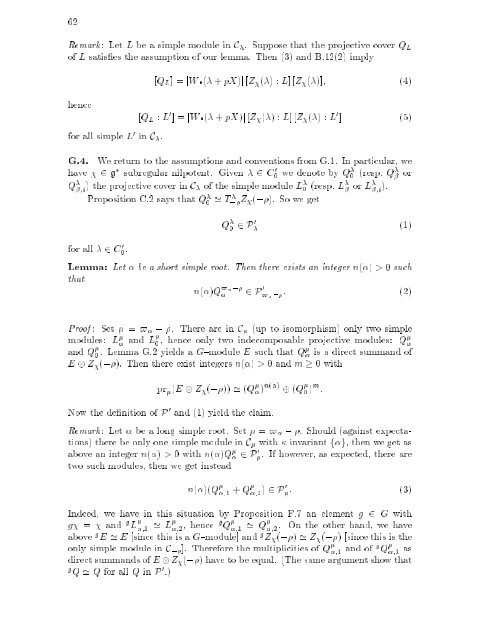subregular nilpotent representations of lie algebras in prime ...
subregular nilpotent representations of lie algebras in prime ...
subregular nilpotent representations of lie algebras in prime ...
Create successful ePaper yourself
Turn your PDF publications into a flip-book with our unique Google optimized e-Paper software.
62<br />
Remark: Let L be a simple module <strong>in</strong> C . Suppose that the projective cover QL<br />
<strong>of</strong> L satis es the assumption <strong>of</strong> our lemma. Then (3) and B.12(2) imply<br />
hence<br />
for all simple L 0 <strong>in</strong> C .<br />
[QL] =jW ( + pX)j [Z ( ):L][Z ( )]; (4)<br />
[QL : L 0 ]=jW ( + pX)j [Z ( ):L][Z ( ):L 0 ] (5)<br />
G.4. We return to the assumptions and conventions from G.1. In particular, we<br />
have 2 g <strong>subregular</strong> <strong>nilpotent</strong>. Given 2 C 0 0 we denote by Q 0 (resp. Q or<br />
Q ;i ) the projective cover <strong>in</strong> C <strong>of</strong> the simple module L 0 (resp. L or L ;i ).<br />
Proposition C.2 says that Q 0 ' T , Z (, ). So we get<br />
for all 2 C 0 0.<br />
Q 0 2P 0<br />
Lemma: Let be ashortsimpleroot. Then there exists an <strong>in</strong>teger n( ) > 0 such<br />
that<br />
n( )Q $ , 2P 0<br />
$ , : (2)<br />
Pro<strong>of</strong> : Set = $ , . There are <strong>in</strong> C (up to isomorphism) only two simple<br />
modules: L and L 0 , hence only two <strong>in</strong>decomposable projective modules: Q<br />
and Q 0 . Lemma G.2 yields a G{module E such thatQ is a direct summand <strong>of</strong><br />
E Z (, ). Then there exist <strong>in</strong>tegers n( ) > 0 and m 0 with<br />
n( )<br />
pr (E Z (, )) ' (Q )<br />
Now the de nition <strong>of</strong> P 0 and (1) yield the claim.<br />
(Q 0 ) m :<br />
Remark: Let be a long simple root. Set = $ , . Should (aga<strong>in</strong>st expectations)<br />
there be only one simple module <strong>in</strong> C with <strong>in</strong>variant f g, thenwegetas<br />
above an<strong>in</strong>teger n( ) > 0withn( )Q 2P 0 .Ifhowever, as expected, there are<br />
two such modules, then we get <strong>in</strong>stead<br />
(1)<br />
n( )(Q ;1 + Q ;2 ) 2P 0 : (3)<br />
Indeed, we have <strong>in</strong> this situation by Proposition F.7 an element g 2 G with<br />
g = and g L ;1 ' L ;2 , hence g Q ;1 ' Q ;2 . On the other hand, we have<br />
above g E ' E [s<strong>in</strong>ce this is a G{module] and g Z (, ) ' Z (, ) [s<strong>in</strong>ce this is the<br />
only simple module <strong>in</strong> C, ]. Therefore the multiplicities <strong>of</strong> Q ;1 and <strong>of</strong> g Q ;1 as<br />
direct summands <strong>of</strong> E Z (, )have to be equal. (The same argumentshow that<br />
g Q ' Q for all Q <strong>in</strong> P 0 .)

















